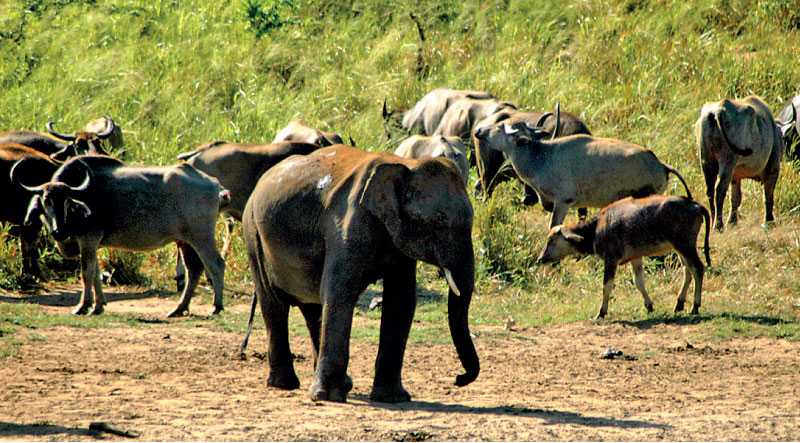Saturday Apr 20, 2024
Saturday Apr 20, 2024
Thursday, 8 October 2020 00:03 - - {{hitsCtrl.values.hits}}

The rampaging domestic herds within the confines of the National Parks – Pic credit Selvam Canagaratna

Vastly outnumbered, the lone elephant struggles for sustenance – Pic credit Acushla Wijesinha
 The Federation of Environmental Organisations (FEO) has, in collaboration with the Department of Wildlife Conservation, engaged in an intensive operation to clear the grasslands of the Minneriya and Kaudulla National Parks from the spread of the Invasive Alien Species ‘Agada’ (Xanthium indicum). This is just the first step.
The Federation of Environmental Organisations (FEO) has, in collaboration with the Department of Wildlife Conservation, engaged in an intensive operation to clear the grasslands of the Minneriya and Kaudulla National Parks from the spread of the Invasive Alien Species ‘Agada’ (Xanthium indicum). This is just the first step.
As the seeds of this weed are carried by water, this will have to be repeated next year, and the year after, to control the spread of this plant that suppresses the growth of the grass needed by the elephants of these parks for much-needed fodder during the times of drought. Of course, there was a mechanism that prevented the widespread dispersal of this weed; the seasonal inundation to capacity, of these reservoirs. Then, in the cultivation season, the water was released for irrigation downstream exposing the lake bed. This not only ensured the growth of lush grasslands, but also that the new seeds of ‘Agada’ were drowned before they could set root.
Regrettably, however, since the construction of the Moragahakanda Reservoir, this seasonal inundation and receding of the waters has not occurred at the right time, and for the required duration. The results are already clear to see. The mass movement of elephants into Minneriya at this time of the year has not happened. There are more to be seen in Kaudulla. This is endangering the world renowned ‘Gathering’ that draws visitors here from all over the world.
A domesticated threat
Apart from the ‘Agada’, another equally destructive menace is the proliferation of herds of domesticated cattle and buffalo within the confines of these parks. As their numbers increase, they too reduce the available grasslands of the reservoir beds.
If the devastating effects possible from this are to be seen firsthand, a trip to the Uda Walawe National Park will suffice. That park, too, has its problems with an invasive alien species, Gandapana Lantana camara, which has been left unmanaged for so long that it is now almost too late to tackle, and has changed the habitat of the park to such an extent that it has altered from grasslands to scrublands.
Where once several hundreds of elephants would find food and water during the season of drought, today one would be lucky to find one or two hundred. Scrubland does not provide sufficient fodder for a large number of elephants, and the methods adopted of trying to manage it, by bulldozing large swathes, taking out all species including the Lantana, just ensures that it is replaced by even more of this species, and of other scrubs. The grasslands have gone forever.
Adding to this devastation is the presence of up to 20,000 domesticated buffalo and cattle, some who have since turned feral, and who compete with the few elephants left for feed. There is no contest. There is little left for the endangered wild species. The grasslands normally left by the receding waters of the reservoir which were vital for the elephants, have been cropped down to the roots and soon turn to a grassless wasteland.
Unless a comprehensive, long-term Management Plan is introduced to systematically remove the Lantana from Uda Walawe and with it, the domestic buffalo and cattle, the days when Uda Walawe had the reputation of being the one place in the world that a sighting of an elephant could be guaranteed 24x7, on 365 days of the year, are drawing to an end. This will also spell doom for over 800 safari jeep drivers, and the employees of over 100 hotels and guest houses that make their living from the elephants of this park.
In addition, how ugly is it that when tourists are promised an experience in the wilds, they see herds of buffalo and cattle instead, all sporting their owners’ brand marks, wandering around, devastating the habitat?
A politically-sponsored invasion
These buffalo and cattle have been intentionally released into the park by local owners in such number that many have been within the park for such a time that they have turned feral. With only a leopard or two that can predate on them, their number has increased exponentially, at the cost of the wildlife.
Taking them out, however, is a problem as the buffalo and cattle owners have powerful political backers and whenever it is tried, the DWC has been thwarted in its efforts. Ironically, the Laws of Sri Lanka, in the form of the Fauna & Flora Protection Ordinance (FFPO), Section 6 (2), (3) & (4) clearly state the following:
(2) No person shall introduce any animal into any Strict Natural Reserve, National Park, Nature Reserve, Jungle Corridor, Refuge, Marine Reserve or Buffer Zone, or Tether, liberate or release any animal therein.
(3) No person shall lead, or allow to stray any domestic animal into any National reserve. It shall be lawful for the Director or any officer authorised by the Director to seize any domestic animal within any National Reserve and to release it to the owner thereof on the payment of a prescribed fine if such animal is claimed within twenty eight days of such seizure. Any animal not so claimed may be disposed of by the Director in such manner as he may deem fit.
(4) Any person who acts in contravention of the provisions of this section shall be guilty of an offence and shall on conviction be liable to imprisonment of either description for a term not less than one year and not exceeding five years.
These are flouted for political expediency and at the cost of the wildlife of the protected areas of Sri Lanka, the economy of the country and, ultimately, the health and well-being of the people of this Nation.
Keeping the cash cow alive
This is a problem that is in its early stages at Minneriya and Kaudulla but, if not acted on swiftly, will result in the reduction of the habitat to the levels it is now at Uda Walawe, a reduction in the number of elephants visiting the Park, and a corresponding increase in the human – elephant conflict as elephants are forced to seek their seasonal requirements outside of the parks.
If not claimed by the owners, these excess cattle and buffalo could be caught and auctioned for dairy production, or given to the National Livestock Development Board (NLDB) where they will be of practical and economic use to the country.
This Government has promised discipline, and this must extend to policymakers and civil servants, as well as to the general public. If these parks are allowed to deteriorate as they are now, Sri Lanka will lose not only its pristine wilderness and the unique species that inhabit them, but will also stop attracting visitors from overseas who are deprived such natural pleasures in their homelands and wish to enjoy them here. This bolsters not only the national coffers but also the local economies bordering these parks and are vital for the future prosperity of this country. In short, in order to keep the cash cow alive, take the domestic cows out of protected areas.
[The writer is Trustee, Federation of Environmental Organisations (FEO).]